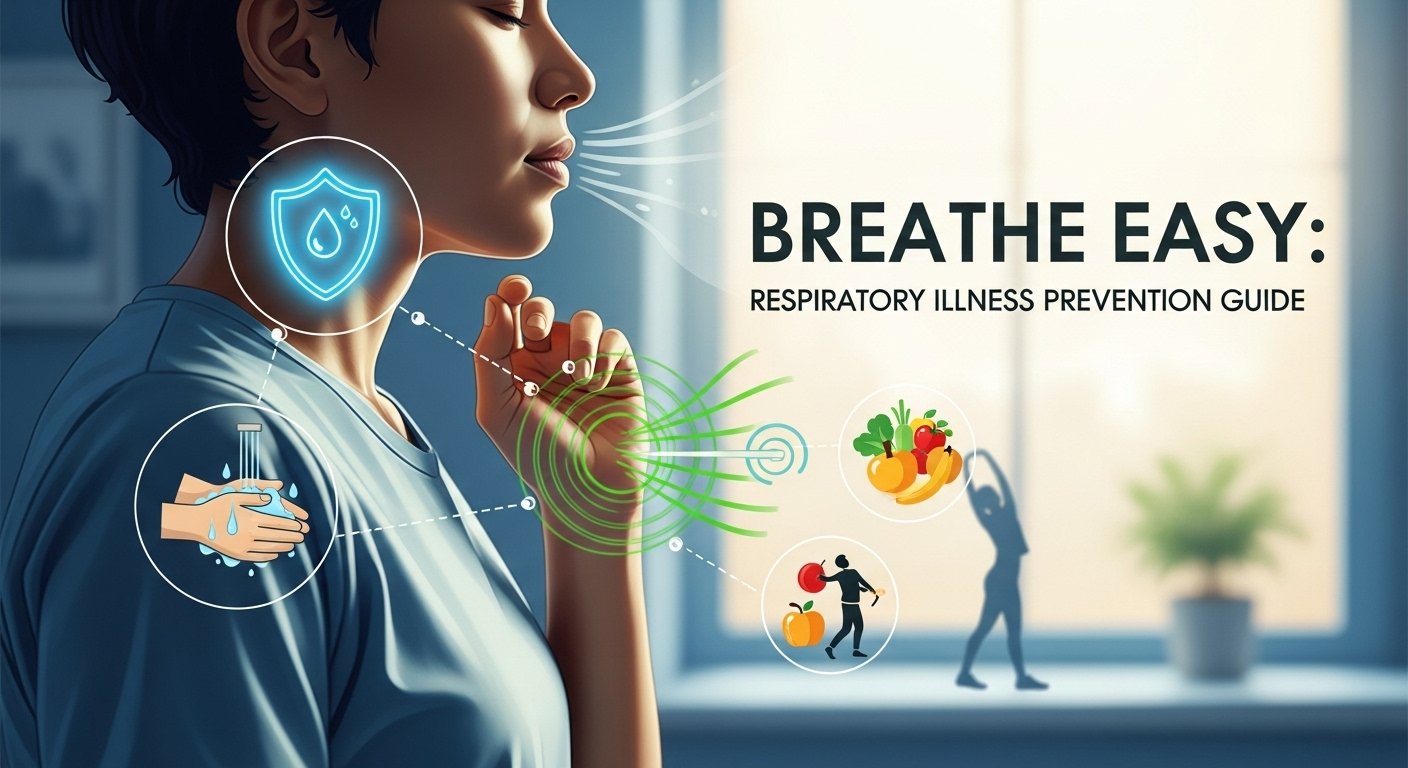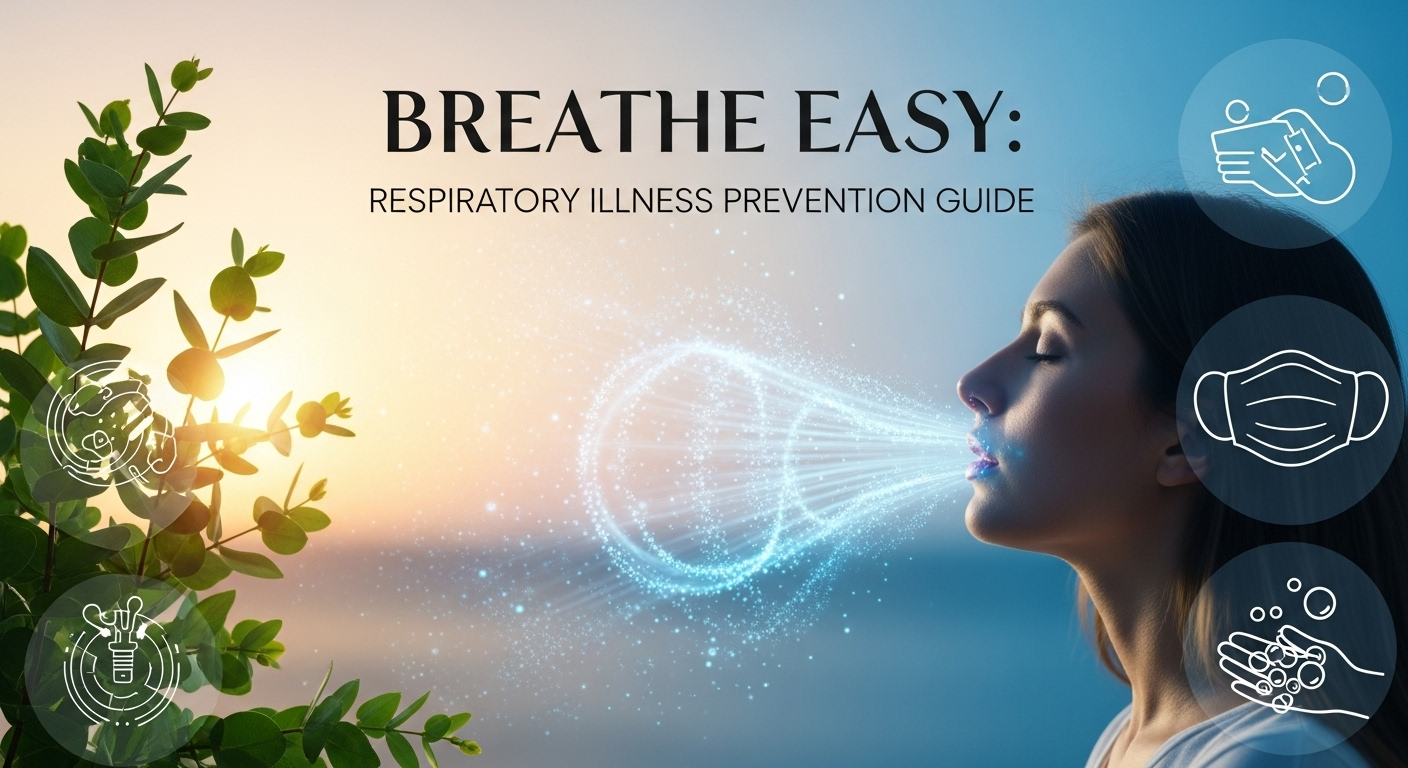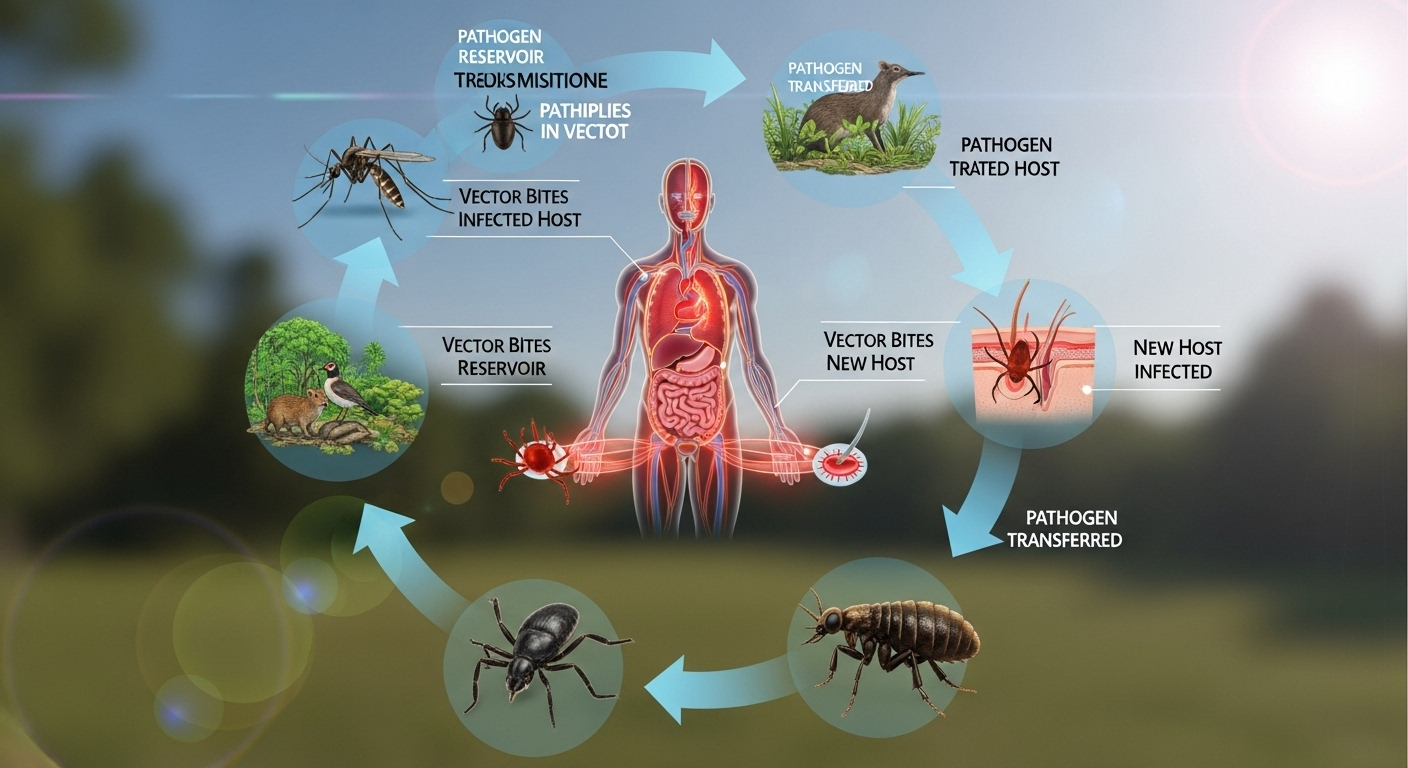In an ideal world, every breath we take would be clean, fresh, and invigorating. However, reality presents a landscape filled with invisible challenges: viruses, bacteria, pollutants, and allergens, all waiting for an opportunity to compromise our respiratory system. From the common cold that disrupts a work week to more serious conditions like influenza or pneumonia, respiratory illnesses are a persistent threat to our well-being. The good news is that we are not defenseless. By adopting a proactive and informed approach, you can significantly reduce your risk and fortify your body's natural defenses. These comprehensive prevention tips for respiratory illnesses are your best defense, serving as a practical guide to help you and your family navigate the seasons with greater confidence and health. This guide will empower you with the knowledge to build a resilient respiratory system, one healthy habit at a time.
Table of Contents
ToggleBreathe Easy: A Comprehensive Respiratory Illness Prevention Guide
The Cornerstone of Prevention: Mastering Personal Hygiene
The first line of defense against respiratory pathogens is not a complex medical procedure or an expensive supplement; it’s the consistent practice of good personal hygiene. Most respiratory viruses and bacteria are transmitted through droplets released when an infected person coughs, sneezes, or talks. These droplets can either be inhaled directly or can land on surfaces, where they can be picked up by our hands. From there, it’s a short trip to our eyes, nose, or mouth—the primary gateways for germs to enter the body. Therefore, mastering simple yet powerful hygiene habits is the single most effective, low-cost strategy to interrupt this chain of transmission.
This isn't just about what you do when you feel sick; it’s about creating a daily routine that protects you and those around you. Think of it as building a shield. Every time you wash your hands correctly or cover a cough, you are reinforcing that shield, making it harder for opportunistic germs to find a way in. Consistency is the key. A single instance of forgetting to wash your hands after touching a public doorknob could be the one that leads to infection. By internalizing these practices, you transform them from conscious efforts into second nature, creating a formidable barrier against a wide array of respiratory illnesses.
The profound impact of hygiene was demonstrated on a global scale during the COVID-19 pandemic, but its principles have been a cornerstone of public health for over a century. It's a testament to the fact that the simplest actions often yield the most significant results. Integrating these habits into your life doesn't just protect you during flu season or an outbreak; it provides year-round protection against countless pathogens, ensuring your respiratory system remains as healthy as possible.
The Art of Effective Handwashing
Handwashing is more than a quick rinse under the tap. To be effective, it must be thorough. The U.S. Centers for Disease Control and Prevention (CDC) recommends washing with soap and water for at least 20 seconds—roughly the time it takes to sing the “Happy Birthday” song twice. The friction from scrubbing, combined with the chemical properties of soap, works to break down the lipid envelope that surrounds many viruses, including influenza and coronaviruses, rendering them inactive and easily washed away.
Make it a non-negotiable routine to wash your hands at critical moments:
- Before preparing or eating food.
- After using the restroom.
- After returning home from a public place (grocery store, office, public transport).
- After blowing your nose, coughing, or sneezing.
- Before and after caring for someone who is sick.
When soap and water are not available, an alcohol-based hand sanitizer with at least 60% alcohol is a suitable alternative. Apply enough sanitizer to cover all surfaces of your hands and rub them together until they are dry.
Mastering Respiratory Etiquette
When you cough or sneeze, you can project respiratory droplets several feet. If you are infectious (even without knowing it), you are actively spreading germs into the air and onto surfaces. The best practice is to always cover your mouth and nose with a tissue, and then immediately dispose of the tissue in a closed bin. If a tissue isn’t available, cough or sneeze into the crook of your elbow, not into your hands. This simple act prevents you from contaminating your hands, which are a primary vehicle for spreading germs to other surfaces and people.
Teaching this "vampire cough" to children from a young age is an excellent way to instill lifelong healthy habits. Furthermore, during periods of high community transmission of illnesses like the flu or COVID-19, wearing a high-quality, well-fitting mask in crowded indoor spaces provides an additional layer of protection, both for you and for others. It contains your own respiratory droplets and filters the air you breathe in, significantly reducing the likelihood of transmission.
Avoid Touching Your Face: The T-Zone Rule
The average person touches their face dozens, if not hundreds, of times per hour, often without even realizing it. This subconscious habit is a direct route for germs from your hands to enter your body. Your eyes, nose, and mouth form what is often called the “T-Zone,” the mucous membranes that are most vulnerable to infection. Even with diligent handwashing, you can pick up germs between washes. Therefore, making a conscious effort to keep your hands away from your T-Zone is a critical preventative measure.
Breaking this habit can be challenging. Start by simply becoming aware of how often you do it. Place sticky notes on your computer monitor or desk as a reminder. If you have an itch on your face, try to use a clean tissue instead of your bare fingers. Reducing face-touching effectively closes one of the most common entry points for respiratory pathogens, complementing your hand hygiene efforts and making your overall defense strategy much more robust.
Bolstering Your Body's Natural Defenses: The Immune System
While external barriers like hygiene are crucial, your ultimate protection against respiratory illness comes from within: your immune system. This complex network of cells, tissues, and organs works tirelessly to identify and neutralize foreign invaders like viruses and bacteria. A strong, well-functioning immune system can often fight off a pathogen before you even notice any symptoms, or at the very least, reduce the severity and duration of an illness if you do get sick. Therefore, focusing on lifestyle choices that support and strengthen your immune function is a cornerstone of long-term respiratory health.
Nourishing your body with the right fuel is fundamental. A diet rich in vitamins, minerals, and antioxidants provides your immune cells with the building blocks they need to operate at peak efficiency. Conversely, a diet high in processed foods, sugar, and unhealthy fats can promote inflammation and suppress immune function, leaving you more vulnerable. Your daily habits, from how much you sleep to how you manage stress, also play a direct and measurable role in your body's ability to defend itself.
Think of your immune system as an army. To be effective, your soldiers (immune cells) need to be well-fed (nutrition), well-rested (sleep), and not constantly under fire from their own command (stress). By adopting a holistic approach that encompasses diet, sleep, and stress management, you are actively training and equipping this internal army to be ready for any battle, ensuring it can mount a swift and effective response against respiratory threats.
Nutrition for Respiratory Resilience
A balanced diet is your pharmacy for immune health. Certain micronutrients are particularly vital for supporting your body’s defenses against respiratory infections.
- Vitamin C: A powerful antioxidant that supports various cellular functions of the immune system. Found in citrus fruits (oranges, grapefruit), bell peppers, strawberries, and broccoli.
- Vitamin D: Often called the "sunshine vitamin," it modulates immune responses. Deficiency is linked to increased susceptibility to infection. It's found in fatty fish (salmon, mackerel), fortified milk, and can be synthesized by the body through sun exposure.
- Zinc: Crucial for the normal development and function of immune cells. Sources include lean meat, shellfish, legumes (chickpeas, lentils), and seeds.
- Antioxidants: Compounds like flavonoids and polyphenols, found in colorful fruits and vegetables (berries, dark leafy greens), help protect your cells from damage and reduce inflammation.
Including a wide variety of these whole foods in your daily diet is far more effective than relying on a single supplement. It provides a synergistic blend of nutrients that work together to fortify your immune response.
The Critical Role of Hydration
Staying well-hydrated is essential for respiratory health. Water plays a key role in supporting your immune system and maintaining the integrity of your respiratory tract. The mucous membranes lining your nose and throat are a critical first line of defense, trapping inhaled particles and pathogens. When you are dehydrated, these membranes can become dry and less effective, creating tiny cracks that can allow viruses to enter.
Furthermore, proper hydration helps to thin the mucus in your airways. This allows the cilia—tiny hair-like structures in your lungs—to more effectively sweep out trapped debris and pathogens, a process known as mucociliary clearance. Aim to drink plenty of fluids, primarily water, throughout the day. Herbal teas and clear broths can also contribute to your daily intake, especially if you are starting to feel unwell.
The Power of Sleep and Stress Management
Never underestimate the restorative power of sleep. While you sleep, your body undergoes critical repair processes, and your immune system releases proteins called cytokines, some of which are essential for fighting infection and inflammation. Chronic sleep deprivation (consistently getting less than 7 hours per night for adults) can suppress the production of these protective cytokines and reduce the effectiveness of your infection-fighting cells, making you significantly more susceptible to viruses like the common cold. Aim for 7-9 hours of quality, uninterrupted sleep per night.
Similarly, chronic stress wreaks havoc on your immune system. When you're stressed, your body produces higher levels of the hormone cortisol. In the short term, cortisol can actually suppress inflammation. However, prolonged elevation of cortisol desensitizes the body to its effects, leading to an increase in inflammation and a dampened immune response. Incorporate stress-management techniques into your daily routine, such as mindfulness meditation, deep breathing exercises, yoga, or spending time in nature.
Proactive Medical Measures: Vaccinations and Health Check-ups
While personal hygiene and a strong immune system are your daily armor, proactive medical interventions like vaccinations and regular health check-ups are your strategic reinforcements. Vaccinations are one of the greatest public health achievements in history, working by training your immune system to recognize and fight specific pathogens without you having to experience the full-blown illness. This pre-emptive training allows your body to mount a much faster and more robust response upon future exposure, preventing the disease entirely or drastically reducing its severity.
Regular check-ups with your healthcare provider are equally important, especially for individuals with underlying health conditions. These appointments provide an opportunity to discuss your specific risks, ensure your vaccinations are up to date, and manage any chronic conditions like asthma or Chronic Obstructive Pulmonary Disease (COPD) that could make you more vulnerable to severe outcomes from a respiratory infection. This collaborative approach with your doctor is a key pillar of long-term respiratory wellness.
Engaging with the healthcare system proactively, rather than reactively when you are already sick, is a fundamental shift in mindset. It's about looking ahead, identifying potential risks, and using the powerful tools of modern medicine to mitigate them. From the annual flu shot to important consultations about lung health, these medical measures provide a level of protection that individual lifestyle choices alone cannot guarantee.
The Critical Role of Annual Vaccinations
The influenza virus is a master of disguise, constantly changing its genetic makeup from one season to the next. This is why an annual flu vaccine is recommended for everyone six months of age and older. Each year, scientists develop a new vaccine to match the strains they predict will be most common. While the flu shot may not always prevent infection completely, it is highly effective at preventing severe illness, hospitalization, and death.
Similarly, staying up-to-date with COVID-19 vaccinations and boosters as recommended by public health authorities is crucial. Like the flu vaccine, COVID-19 vaccines have been proven to significantly reduce the risk of severe disease, hospitalization, and long-term complications. By getting vaccinated, you are not only protecting yourself but also contributing to herd immunity, which helps protect the most vulnerable members of your community who may not be able to get vaccinated or who have a weaker immune response.

Other Important Vaccines for Respiratory Health
Beyond the annual flu and COVID-19 shots, other vaccines play a vital role in preventing specific respiratory illnesses. The pneumococcal vaccine is highly recommended for young children, all adults 65 years or older, and individuals with certain chronic health conditions. It protects against Streptococcus pneumoniae bacteria, a leading cause of bacterial pneumonia, meningitis, and bloodstream infections. Pneumonia is often a serious complication of a viral infection like the flu, so this vaccine provides a critical secondary layer of defense.
The Tdap vaccine (Tetanus, Diphtheria, and Pertussis) is also important. The "P" in Tdap protects against pertussis, better known as whooping cough. This is a highly contagious and severe respiratory infection that can be especially dangerous for infants. Adults need a Tdap booster, as immunity can wane over time. Ensuring your Tdap is current is vital, particularly if you will be around newborns or young children.
Creating a Healthy Living Environment
The air you breathe and the environment you live in have a direct impact on your respiratory health. While you can’t control the outdoor air quality completely, you have significant control over your indoor environment, where most people spend up to 90% of their time. Indoor air can be two to five times more polluted than outdoor air, containing a mix of dust mites, pet dander, mold spores, and volatile organic compounds (VOCs) from cleaning products and furniture. These irritants can inflame your airways and make you more susceptible to infections.
Furthermore, the way you navigate public spaces influences your exposure risk. During peak respiratory virus season, being mindful of crowded, poorly ventilated areas can dramatically reduce your chances of inhaling infectious droplets. Creating a healthy environment is a two-pronged approach: optimizing the quality of your personal space (home and office) and making smart decisions when you are in public spaces.
This focus on your surroundings adds another robust layer to your prevention strategy. It complements personal hygiene and immune support by reducing the overall "pathogen load" you are exposed to daily. A clean, well-ventilated space with minimal irritants gives your respiratory system a break, allowing it to function optimally and be better prepared to handle any pathogens it does encounter.
Improving Indoor Air Quality
One of the simplest and most effective ways to improve indoor air quality is through proper ventilation. Open your windows for 10-15 minutes each day, even in colder weather, to allow fresh air to circulate and flush out stale, polluted indoor air. Using exhaust fans in your kitchen and bathroom also helps remove moisture and contaminants at the source.
For an added layer of protection, consider using a high-efficiency particulate air (HEPA) filter. These can be standalone air purifier units or can be installed in your HVAC system. A true HEPA filter is certified to capture 99.97% of airborne particles as small as 0.3 microns, which includes dust, pollen, mold, bacteria, and virus-carrying droplets. Maintaining a healthy humidity level (between 30-50%) with a humidifier or dehumidifier can also help, as viruses tend to survive longer in very dry or very damp conditions.
Limiting Exposure to Pollutants and Irritants
Cigarette smoke is one of the most damaging respiratory irritants. If you smoke, the single best thing you can do for your respiratory health is to quit. Smoking damages the cilia in your lungs, paralyzing the cleaning mechanism that removes mucus and trapped pathogens. It also causes chronic inflammation, making you far more vulnerable to infections like pneumonia and bronchitis. Avoiding secondhand smoke is just as important.
Be mindful of other airborne irritants as well. Strong fumes from cleaning products, paints, and air fresheners can irritate your respiratory tract. Opt for fragrance-free or natural cleaning products when possible and ensure good ventilation when you do use strong chemicals. On days when outdoor air pollution levels are high, try to limit strenuous outdoor activities.
Differentiating and Managing Early Symptoms
Even with the best prevention strategies, you might occasionally fall ill. Recognizing the early symptoms and knowing how they differ between common respiratory illnesses can help you take appropriate action quickly—whether it’s self-isolating to protect others, seeking medical advice, or simply getting the rest you need. Distinguishing between a common cold, the flu, allergies, and COVID-19 can be confusing as they share many overlapping symptoms.
Understanding these key differences is empowering. It allows you to manage the illness effectively and make informed decisions about your health and the health of those around you. For example, recognizing the sudden, high-intensity onset of the flu might prompt you to contact your doctor about antiviral medications, which are most effective when taken within the first 48 hours. Identifying allergy symptoms, on the other hand, can save you from unnecessary worry and guide you toward antihistamines instead. The following table provides a general guide to help you differentiate.
Symptom Comparison: Cold vs. Flu vs. Allergies vs. COVID-19
| Symptom | Common Cold | Influenza (Flu) | Seasonal Allergies | COVID-19 |
|---|---|---|---|---|
| Fever | Rare | Common, high (100°F+) | Never | Common, can be high |
| Cough | Common (mild to moderate) | Common, usually dry and severe | Sometimes (mild) | Common, usually dry |
| Aches & Pains | Slight | Common and often severe | Never | Common |
| Fatigue/Weakness | Mild | Common and can be extreme | Sometimes (mild) | Common, can be severe |
| Sneezing | Common | Sometimes | Very Common | Sometimes |
| Stuffy/Runny Nose | Very Common | Sometimes | Very Common | Common |
| Sore Throat | Very Common | Common | Sometimes (itchy/scratchy) | Common |
| Itchy, Watery Eyes | Rare | Rare | Very Common | Rare |
| Loss of Taste/Smell | Rare | Rare | Never | Common, can be sudden |
| Onset of Symptoms | Gradual | Sudden and intense | Varies with exposure | Gradual |
Note:</strong> This table is a general guide. Symptoms can vary greatly by individual. If you are concerned about your symptoms, especially if you have a high fever or difficulty breathing, contact a healthcare professional.
Frequently Asked Questions (FAQ)
Q1: Do face masks actually work in preventing respiratory illnesses?
A: Yes, absolutely. High-quality, well-fitting masks work in two primary ways. First, they act as "source control," trapping your own respiratory droplets and preventing you from spreading germs if you are unknowingly infectious. Second, they provide personal protection by filtering the air you breathe in, reducing your exposure to infectious particles from others. For best protection in high-risk settings, N95, KN95, or KF94 respirators are more effective than cloth or surgical masks.
Q2: Are supplements like Vitamin C and Zinc effective at preventing colds?
A: While a balanced diet rich in these nutrients is crucial for immune function, the evidence for high-dose supplements as a preventative measure is mixed. Some studies suggest that regular zinc supplementation may reduce the incidence of the common cold, and taking it at the first sign of symptoms might shorten its duration. High-dose Vitamin C has not been shown to prevent colds in the general population but may slightly reduce the duration of an illness. Your best bet is to focus on getting these nutrients from whole foods. Always consult a doctor before starting a new supplement regimen.
Q3: How often should I get the flu shot if I am healthy?
A: The flu shot is recommended annually for everyone aged six months and older, regardless of their health status. The influenza virus mutates rapidly, so each year a new vaccine is formulated to protect against the strains that are expected to be most prevalent. Your immunity from a previous shot wanes over time, so an annual vaccination is necessary to ensure you have the best possible protection for the upcoming flu season.
Q4: Can exercise help prevent respiratory illnesses?
A: Yes, regular, moderate exercise is an excellent way to boost your immune system. Activities like brisk walking, cycling, or swimming enhance the circulation of immune cells, helping them detect and eliminate pathogens more effectively. However, it's a matter of balance. Overtraining or intense, prolonged exercise can temporarily suppress the immune system, so it's important to listen to your body and ensure adequate recovery. If you are already feeling sick, it's best to stick to very light activity or rest completely.
Conclusion
Protecting yourself from respiratory illnesses is not about a single magic bullet, but rather the consistent application of a multi-layered strategy. It begins with the simple yet profound acts of personal hygiene—washing your hands, covering your coughs, and avoiding touching your face. It extends to nurturing your body from the inside out by bolstering your immune system through a nutrient-rich diet, adequate sleep, and stress management. It involves being mindful of your environment by ensuring clean indoor air and making smart choices in public spaces. Finally, it is reinforced by the powerful tools of modern medicine, primarily through vaccinations and regular health check-ups.
Each of these pillars works in concert, creating a robust shield that significantly lowers your risk of infection and lessens the severity of illness if you do get sick. By embracing these practices, you are not just avoiding a seasonal nuisance; you are making a long-term investment in your health, vitality, and overall well-being. Taking control of your respiratory health is one of the most powerful and empowering actions you can take. Breathe easy, stay informed, and be well.
***
Article Summary
The "Breathe Easy: Respiratory Illness Prevention Guide" provides a comprehensive, actionable strategy for safeguarding your respiratory health. The article outlines a multi-layered defense system built on four key pillars: mastering personal hygiene (effective handwashing, respiratory etiquette), bolstering the immune system (through nutrition, sleep, and stress management), creating a healthy living environment (improving indoor air quality), and leveraging proactive medical measures (vaccinations for flu, COVID-19, and pneumonia). It emphasizes that consistent application of these simple habits is the most effective way to reduce the risk of common and serious respiratory infections. The guide also includes a valuable comparison table to help differentiate symptoms of a cold, flu, allergies, and COVID-19, along with an FAQ section that addresses common questions about masks and supplements, making it an essential resource for anyone looking to proactively protect their health year-round.














